Overview
The article addresses the significant challenges developers face in the software development process. It emphasizes the critical role of the Software Development Life Cycle (SDLC) in streamlining development. Kodezi offers solutions that integrate essential tools and methodologies, such as:
- Automated documentation
- Agile practices
- Testing phases
- CI/CD practices
These features collectively enhance productivity and ensure quality in project management. Furthermore, by utilizing Kodezi, developers can expect improved efficiency and code quality. Explore the tools available on the platform to transform your development experience.
Introduction
In the rapidly evolving landscape of software development, developers often encounter significant challenges that hinder their productivity. How can these issues be addressed effectively? Enter Kodezi, a tool designed to automate documentation and streamline coding processes. With features that enhance collaboration and efficiency, Kodezi stands out as a solution that not only simplifies tasks but also improves code quality.
The Software Development Life Cycle (SDLC) encompasses various methodologies, including Agile and Waterfall, each offering unique approaches to project management. By integrating effective project management tools, rigorous testing, and security measures, organizations can significantly enhance their SDLC outcomes. Furthermore, embracing innovation and adaptability is essential in today’s competitive environment.
By examining the latest trends and best practices, it becomes evident that using Kodezi can lead to improved productivity and better project outcomes. Are you ready to explore the tools available on this platform and transform your coding practices? Embrace the change that Kodezi offers and drive your success in software development.
Kodezi | Professional OpenAPI Specification Generator - AI Dev-Tool: Streamline Your SDLC Process
Developers often face significant challenges in managing documentation alongside coding tasks. Kodezi serves as a powerful tool designed to alleviate these issues, particularly in generating OpenAPI specifications. By automating the documentation process and synchronizing API documentation with code changes, Kodezi allows teams to focus on coding rather than manual documentation. This streamlining of the SDLC components not only boosts productivity but also ensures that the specifications generated meet professional standards. Consequently, teams can maintain clarity and consistency throughout the development process.
As Markus Breuer aptly notes, 'Embracing abstraction enables programmers to create robust and scalable solutions that can adapt to evolving requirements.' This principle is central to Kodezi's functionality, as it effectively simplifies the documentation process, enabling developers to produce high-quality specifications efficiently.
Furthermore, recent statistics indicate a notable increase in the adoption of automated documentation tools among developers in 2025, underscoring the growing importance of such solutions in modern software development. Kodezi exemplifies this trend by enhancing its SDLC components through capabilities such as the automatic generation of Swagger sites for API testing. For instance, it assists programmers in leveraging polymorphism by allowing the definition of interfaces and abstract types, which fosters dynamic function resolution and ultimately enhances programming productivity.
To fully harness Kodezi's capabilities, teams are encouraged to explore its features for generating OpenAPI specifications and automatically creating Swagger sites for API testing. By doing so, they can streamline their documentation efforts and significantly improve overall efficiency.
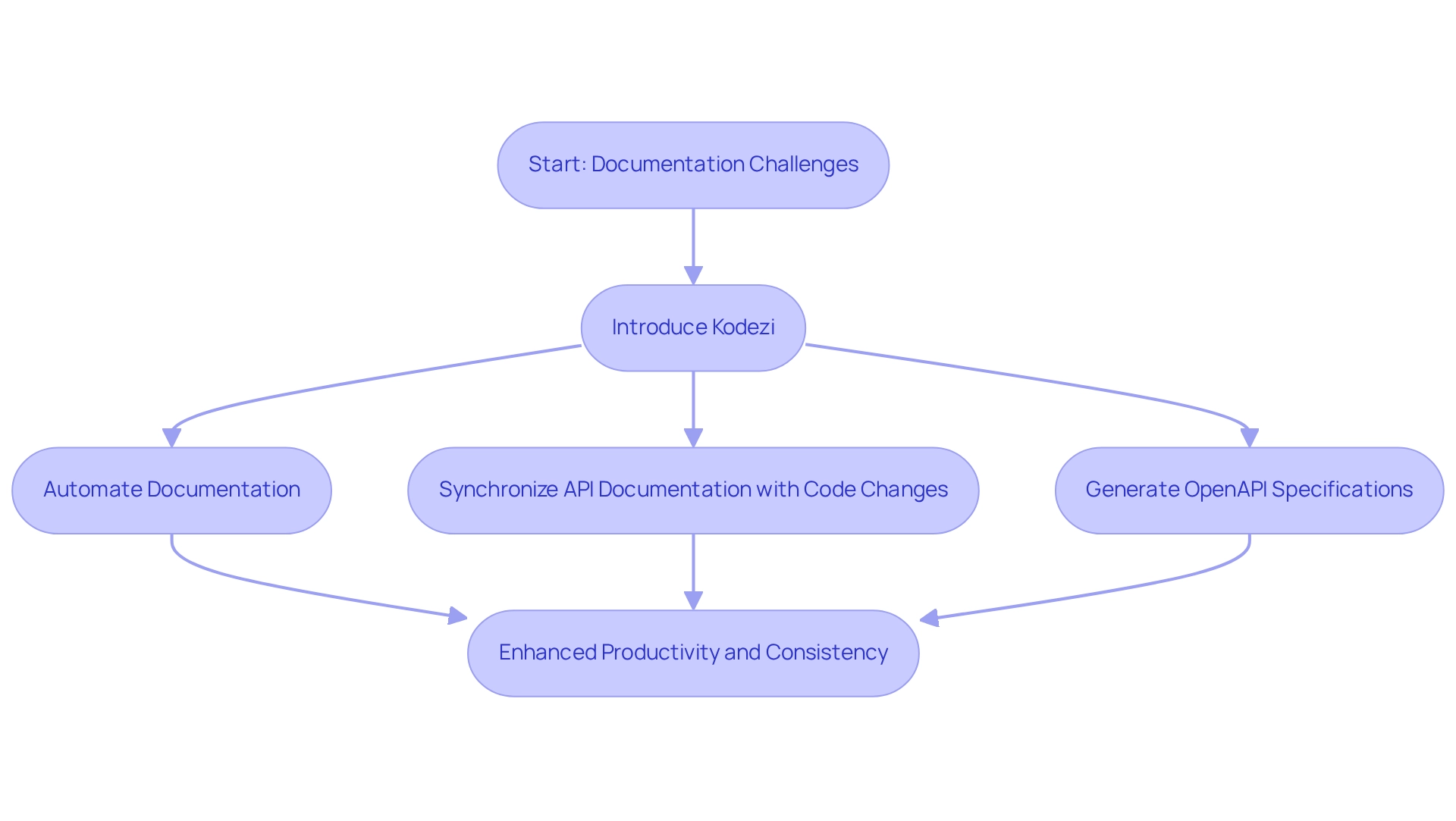
Agile Model: Emphasizing Flexibility and Iterative Development
The Agile model highlights the importance of adaptability and customer collaboration, allowing teams to respond to changing requirements throughout the development process. By segmenting projects into smaller, manageable increments, Agile promotes continuous feedback and enhancement. This iterative approach not only boosts team productivity but also leads to increased customer satisfaction, as products evolve based on user input.
Interestingly, 74% of agile marketers assert that implementing an agile workflow across departments would enhance collaboration, a crucial factor for improving software development outcomes. Furthermore, a study revealed that 27% of teams identified the absence of clearly defined metrics as a major barrier to successful Agile transformation.
Establishing measurable goals can significantly improve Agile implementation, enabling teams to monitor progress and adapt their strategies effectively. As more organizations embrace Agile methodologies, the iterative development process continues to demonstrate its capacity to improve results and stimulate innovation.

Waterfall Model: A Structured Approach to Software Development
The Waterfall model is defined by its sequential phases, where each stage must be completed before the next begins. This organized method is particularly suitable for projects with clear, unchanging requirements, enabling comprehensive documentation and planning. However, its rigidity can pose challenges in dynamic environments that require flexibility. Understanding when to apply the Waterfall model can help teams manage expectations and ensure timely delivery of results.
Interestingly, studies indicate that projects utilizing the Waterfall methodology achieve a success rate of approximately 49%, compared to 64% for those employing Agile techniques. Furthermore, statistics reveal that Microsoft Project and Microsoft TFS each have a 21% usage rate for Agile management, highlighting the growing preference for Agile methodologies across various initiatives. Experts suggest that among the SDLC components, the Waterfall model is most effective for projects with fixed requirements, such as those in regulated industries or software development for stable environments.
In contrast, Michael Singer emphasizes that Agile management offers an iterative approach better suited to accommodate changing requirements. Case studies illustrate successful implementations of the Waterfall model in large-scale projects, where structured processes resulted in predictable outcomes. Nevertheless, as Cornelius Fichtner points out, managing group dynamics is crucial, and recognizing the strengths and weaknesses of the Waterfall model is essential for effective application development.
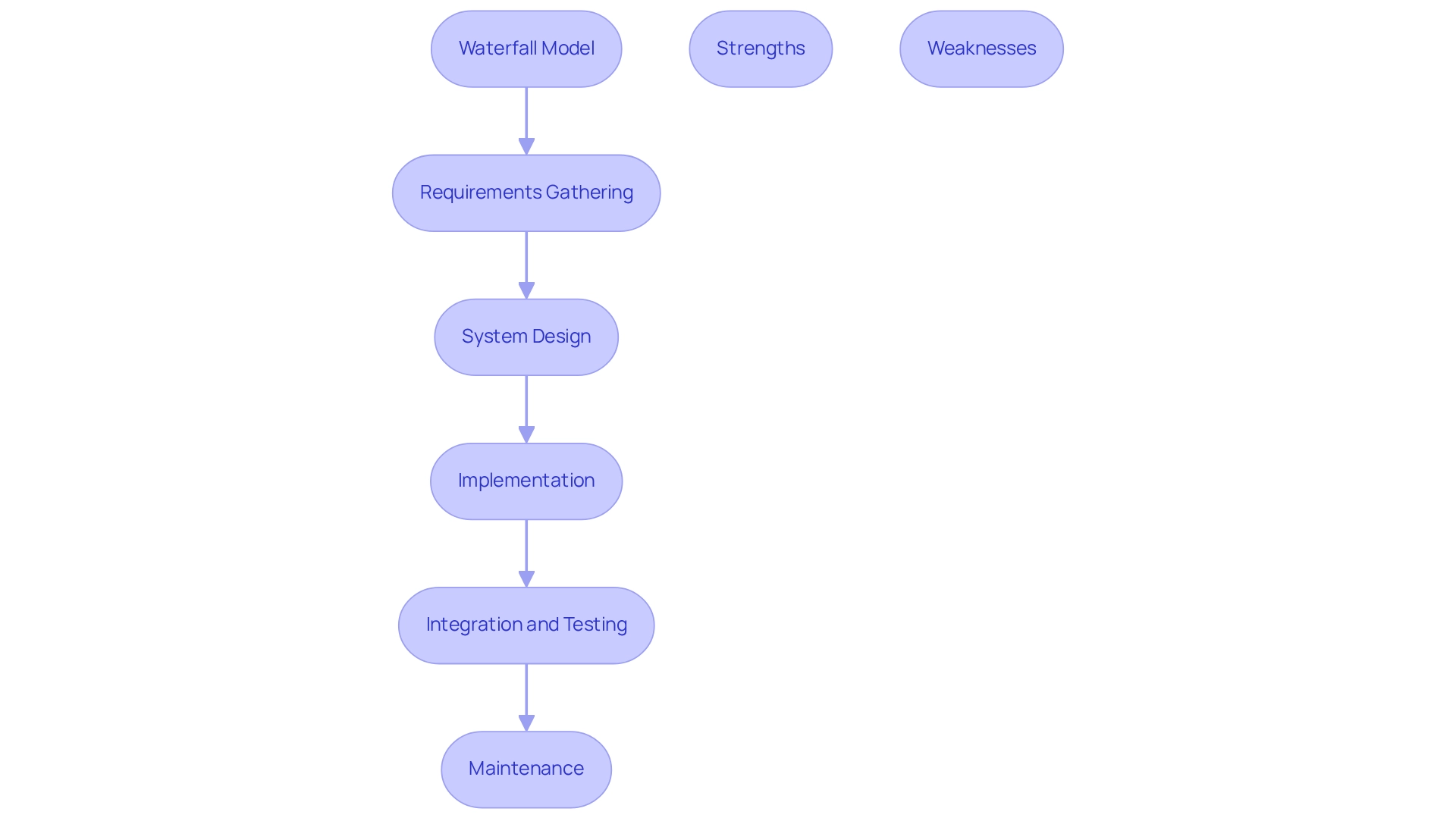
Testing Phase: Ensuring Quality Through Rigorous Evaluation
The testing phase is a critical SDLC component of the Software Development Life Cycle (SDLC), focusing on the identification and resolution of defects before deployment. This phase employs rigorous evaluation methods, such as:
- Unit testing
- Integration testing
- User acceptance testing
These methods ensure that the final product aligns with both functional and non-functional requirements. Furthermore, by implementing a robust testing strategy in the SDLC components, teams can significantly reduce the likelihood of post-deployment issues and enhance overall quality.
Have you considered how a comprehensive testing approach could transform your development process? By prioritizing testing, you not only safeguard your product but also boost team confidence and client satisfaction.
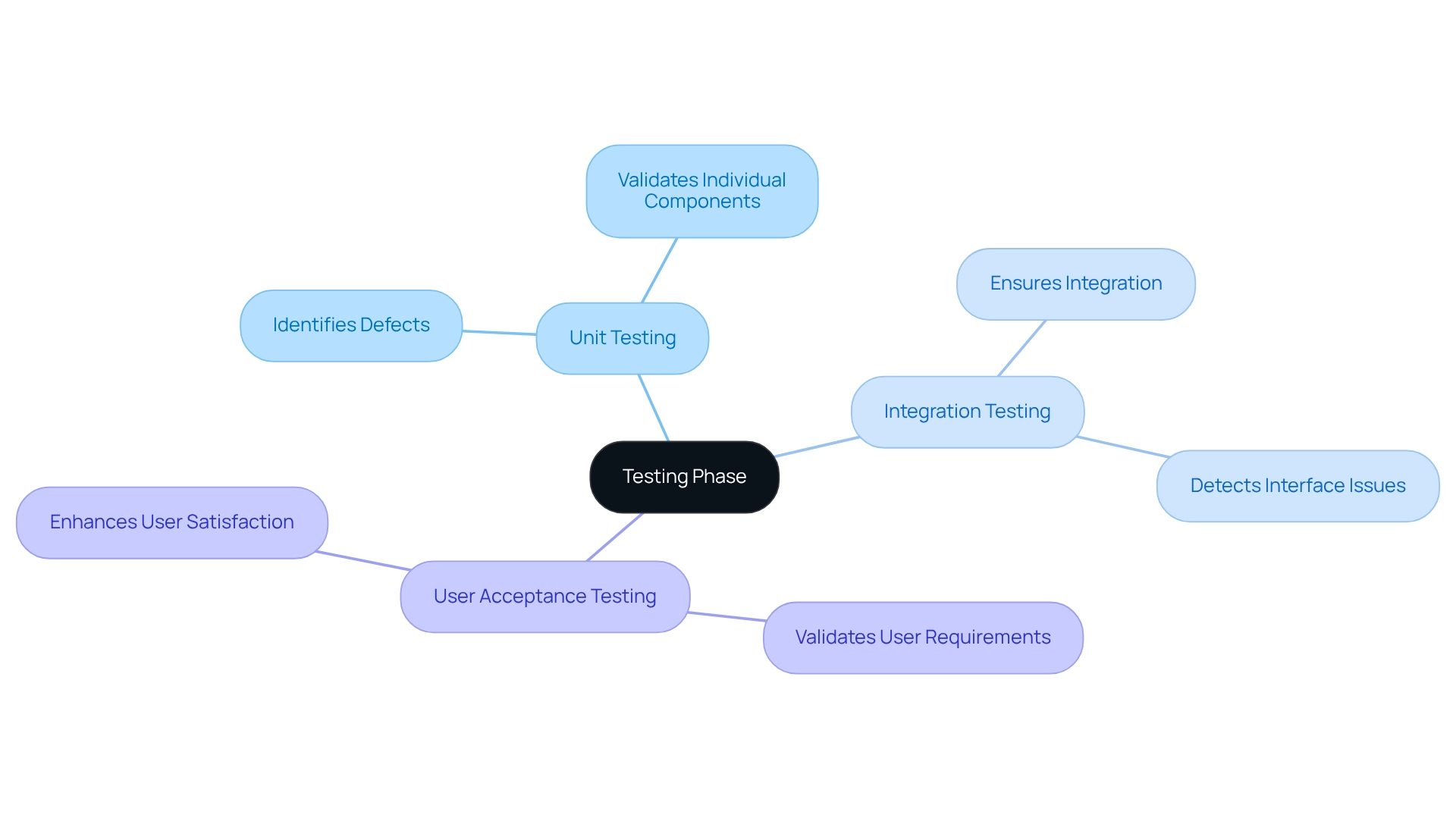
Deployment Phase: Transitioning Software to Production
The deployment phase is critical for transferring applications to end-users, necessitating meticulous planning and execution to guarantee a seamless rollout. Effective strategies incorporate the use of staging environments, comprehensive rollback plans, and robust user training programs, all designed to minimize risks associated with new releases. For instance, organizations that have embraced DevOps practices reported 2.8 times more frequent application deployments in 2023, underscoring the efficiency achieved through structured methods. Furthermore, a strong emphasis on user training significantly impacts application adoption rates, as it equips users with the essential skills needed to navigate new systems confidently.
Best practices for 2025 highlight the necessity of clear communication and thorough preparation, which not only enhance user satisfaction but also mitigate potential disruptions. As deployment specialists note, minimizing risks during rollout is paramount; their insights suggest that proactive measures can lead to a more successful deployment experience. In addition, with a projected 35% increase in investment in DevSecOps practices by 2024, organizations are increasingly concentrating on automated security and compliance processes, further advancing digital transformation and enabling quicker, more secure application releases. By integrating these strategies, teams can ensure a seamless transition that promotes user engagement and satisfaction.
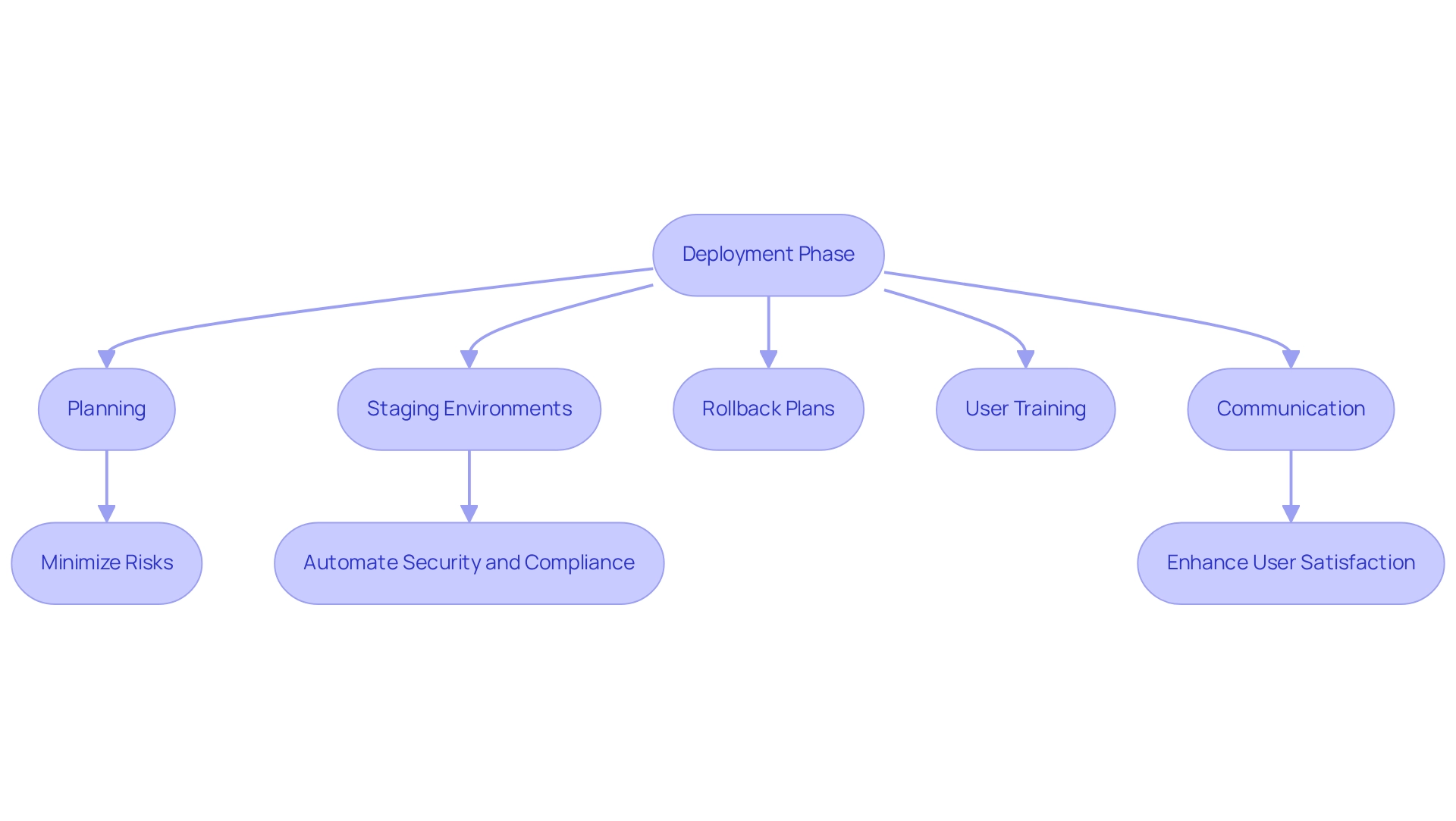
Maintenance Phase: Keeping Software Up-to-Date and Functional
The maintenance phase encompasses crucial tasks such as bug fixes and performance improvements, essential for keeping applications operational and up to date after deployment. Regular maintenance is vital, as it prolongs the system's lifespan and ensures continued value for users.
Companies adopting proactive maintenance strategies, like utilizing tools such as Kodezi CLI—the B2B Swiss Army Knife for Engineering Teams—can significantly reduce inefficiencies. A 2021 study revealed that many U.S. companies faced challenges in their maintenance processes, with metrics like Mean Time To Repair and Overall Equipment Effectiveness requiring urgent attention.
Furthermore, predictive analytics can lead to a remarkable 40% improvement in service reliability, underscoring the benefits of regular updates. By addressing issues before they escalate, teams can effectively adapt to changing market demands.
Successful examples of bug fixing and performance enhancement post-deployment illustrate the tangible benefits of a well-structured maintenance approach. Implementing maintenance best practices in 2025 will be crucial for organizations seeking to enhance operations and guarantee long-term application viability.

Documentation: Maintaining Clarity and Communication
Effective documentation is essential for fostering clarity and communication among team members and stakeholders. It serves as a vital reference for understanding software functionalities, design decisions, and user instructions. In 2025, the significance of documentation has only grown, with studies indicating that proper documentation can save substantial time in the long run. For instance, inefficient document management can cost businesses over $600 billion annually due to data entry errors and lost documents, as highlighted in the case study titled "The Financial Cost of Inefficient Document Management," underscoring the need for robust documentation practices.
By following best practices—such as using clear language, standardized formats, and ensuring accessibility, as highlighted in recent guidelines for creating technical documentation—teams can significantly enhance collaboration and maintain knowledge throughout the project lifecycle. Furthermore, expert opinions emphasize that if developers cannot explain how their code works, they cannot expect others to understand it, reinforcing the necessity of well-structured documentation. In addition, efficient documentation enhances group communication and simplifies the development process, ultimately resulting in improved outcomes.

Project Management Tools: Enhancing Efficiency in SDLC
Project management tools are essential for overcoming the challenges developers face within the SDLC components. They provide a centralized platform for task management, collaboration, and progress tracking. Tools like Jira, Trello, and Asana empower teams to visualize workflows, prioritize tasks, and enhance communication. How can these tools transform your team's efficiency? By utilizing them, organizations can streamline processes, mitigate bottlenecks, and effectively maintain timelines and budgets.
Statistics reveal that organizations employing standardized management practices save 28 times more money than those that do not. This underscores the financial advantages of using tools like Jira and Trello. Furthermore, as of 2022, 77% of high-achieving groups utilize project management software. This highlights its significance in achieving project success, as noted by Business Management Daily.
The shift toward smaller, more agile teams is evident, with 53% of organizations anticipating this approach. Project management tools facilitate this transition by providing the essential framework and adaptability needed for teams to respond swiftly to evolving demands. Similarly, this trend aligns with the increasing reliance on management tools to drive digital transformation, as 90% of organizations are currently undergoing some type of change, with 48% focusing on Environmental, Social, and Governance (ESG) initiatives.
Integrating tools such as Jira and Trello not only enhances team efficiency but also significantly impacts outcomes. Managers have noted that these tools improve resource allocation and foster teamwork, leading to more successful task completions. By adopting management tools, teams can navigate the complexities of the SDLC components with greater agility and efficiency. To fully leverage these benefits, teams should consider incorporating project management tools into their workflows to enhance productivity and project success.

Security Integration: Incorporating DevSecOps into SDLC
Incorporating security into the SDLC components through DevSecOps practices is essential for addressing security challenges at every stage of development. This proactive methodology integrates security testing, threat modeling, and vulnerability assessments directly into the workflow. By prioritizing security from the outset, project teams can significantly mitigate risks and bolster the overall security posture of their applications.
As Chris Wysopal aptly states, "Security must be designed in from the very beginning," underscoring the necessity for a foundational approach to security. This not only protects user data but also cultivates trust among users. Notably, 74% of professionals express concerns that legacy application security tools render them vulnerable to supply chain risks, highlighting the urgent need for modern security integration.
Furthermore, organizations like Cyb-Uranus exemplify the effectiveness of tailored cybersecurity strategies for startups and SMEs, demonstrating that a people-first approach enhances resilience against cyber threats. Their focus on integrating security within the SDLC components illustrates how DevSecOps practices can significantly enhance application development processes and ensure robust application security.
As we look towards 2025, the integration of DevSecOps into the SDLC components will be a pivotal factor in enhancing application development processes and ensuring strong application security.

CI/CD Practices: Accelerating Software Development and Deployment
In today's fast-paced development landscape, developers often encounter significant challenges in managing code changes efficiently. CI/CD practices provide a solution by allowing teams to automate the integration and deployment of code alterations, thereby streamlining the development lifecycle and its SDLC components. By adopting CI/CD pipelines, organizations can ensure continuous testing and deployment of code, which minimizes defects and enhances overall application quality.
How does Kodezi tackle these challenges? With its innovative single-click code generation feature, Kodezi exemplifies how automation can revolutionize coding processes. This feature allows developers to focus on more complex challenges while producing high-quality code swiftly. Furthermore, the integration of CI/CD practices fosters a collaborative environment that encourages rapid iteration, enabling teams to swiftly adapt to user feedback and evolving market demands.
The benefits of using Kodezi are clear: organizations embracing DevOps, CI/CD, and containerization have reported remarkable improvements in efficiency and productivity. Notably, the integration of CI/CD practices in 2025 continues to demonstrate significant advantages for developers, particularly through the effective utilization of SDLC components, including enhanced deployment efficiency and improved code quality.
Are you ready to elevate your coding practices? Explore the tools available on the Kodezi platform and experience the transformative impact of CI/CD methodologies on modern software development.
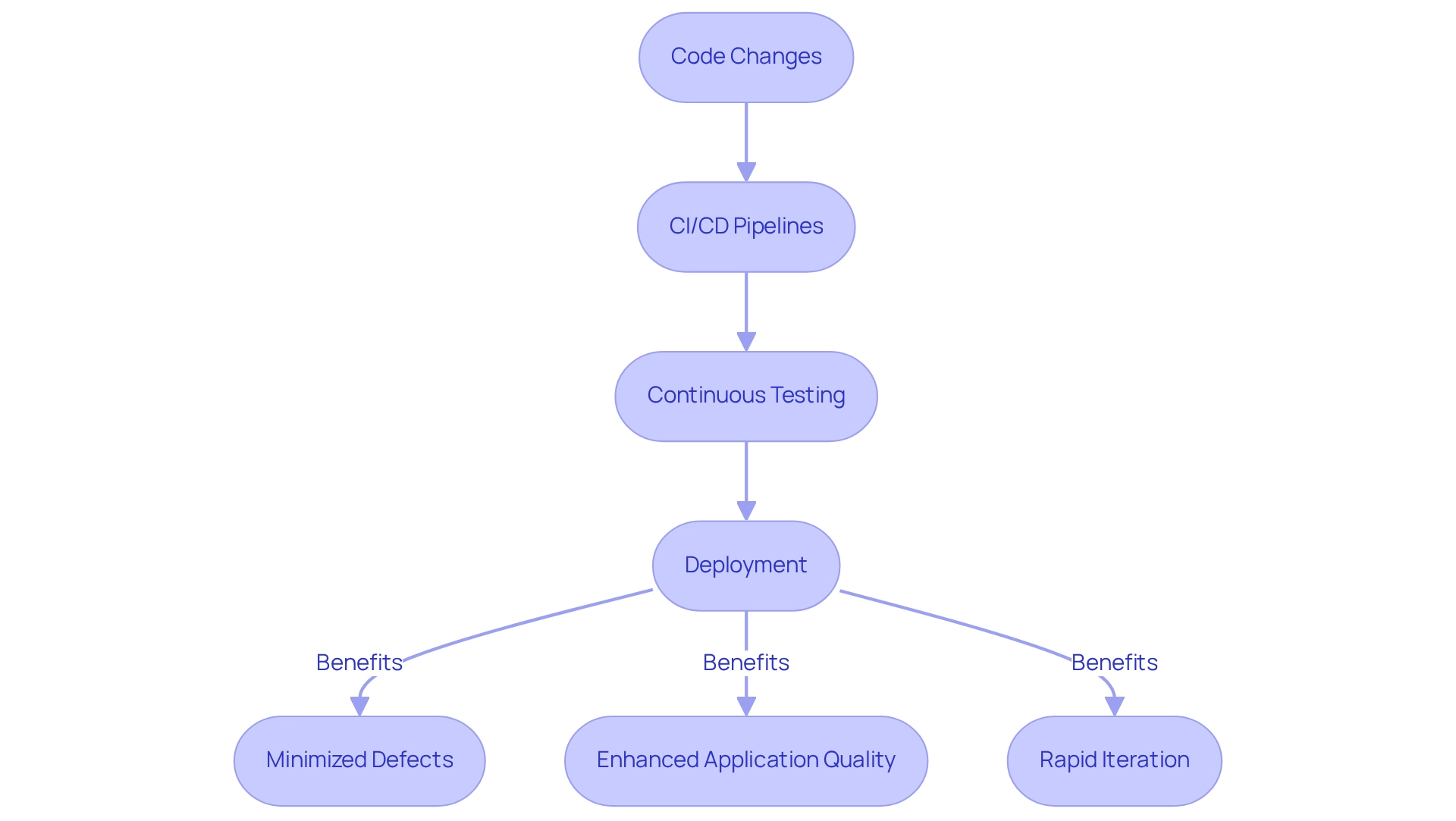
Conclusion
The challenges developers face in coding are significant, often hindering productivity. Kodezi emerges as a powerful solution, addressing these challenges through features that automate documentation and synchronize API documentation with code changes. This allows teams to devote their time to coding instead of manual documentation, streamlining processes and ensuring adherence to professional standards. The alignment with modern trends highlights the growing importance of automated tools in software development.
In addition to Kodezi, various methodologies such as Agile and Waterfall are explored, showcasing how different approaches can be leveraged to enhance project outcomes. The Agile model, with its emphasis on flexibility and iterative development, contrasts with the Waterfall model, which offers a structured approach suited for projects with fixed requirements. Understanding when to apply each methodology can lead to successful project delivery, capitalizing on their unique strengths.
Furthermore, the discussion on best practices across the SDLC phases—from testing and deployment to maintenance and documentation—reinforces the necessity of rigorous evaluation and proactive strategies. Embracing project management tools and integrating security through DevSecOps significantly enhances efficiency and safeguards against risks, ensuring robust application security.
As organizations navigate the complexities of software development, leveraging innovative tools like Kodezi and adopting modern practices will be essential for driving success. The commitment to continuous improvement and adaptation in the SDLC fosters better collaboration and communication, positioning teams to effectively meet the evolving demands of the industry. Embracing these changes is crucial for achieving superior project outcomes and maintaining a competitive edge in the fast-paced world of software development.
Frequently Asked Questions
What challenges do developers face in managing documentation alongside coding tasks?
Developers often struggle with managing documentation while coding, which can hinder productivity and lead to inconsistencies in project specifications.
How does Kodezi help alleviate documentation challenges?
Kodezi automates the documentation process and synchronizes API documentation with code changes, allowing teams to focus more on coding rather than manual documentation.
What are the benefits of using Kodezi for documentation?
Kodezi boosts productivity, ensures that specifications meet professional standards, and maintains clarity and consistency throughout the development process.
What principle is central to Kodezi's functionality?
The principle of embracing abstraction is central to Kodezi, enabling programmers to create robust and scalable solutions that adapt to evolving requirements.
How has the adoption of automated documentation tools changed recently?
There has been a notable increase in the adoption of automated documentation tools among developers in 2025, highlighting their growing importance in software development.
What specific features does Kodezi offer?
Kodezi offers features such as the automatic generation of OpenAPI specifications and Swagger sites for API testing, which enhance the software development life cycle (SDLC).
What is the Agile model, and how does it benefit software development?
The Agile model emphasizes adaptability and customer collaboration, allowing teams to respond to changing requirements, which boosts productivity and customer satisfaction through continuous feedback and enhancement.
What statistic highlights the importance of Agile workflows?
74% of agile marketers believe that implementing an agile workflow across departments would enhance collaboration, which is crucial for improving software development outcomes.
What barriers to successful Agile transformation do teams face?
A study found that 27% of teams identified the absence of clearly defined metrics as a major barrier to successful Agile transformation.
When is the Waterfall model most effectively applied?
The Waterfall model is most effective for projects with clear, unchanging requirements, such as those in regulated industries or stable environments.
How do success rates compare between Waterfall and Agile methodologies?
Projects using the Waterfall methodology have a success rate of approximately 49%, while those employing Agile techniques achieve a success rate of 64%.
What is crucial for effective application development when using the Waterfall model?
Understanding the strengths and weaknesses of the Waterfall model and managing group dynamics are crucial for effective application development.




